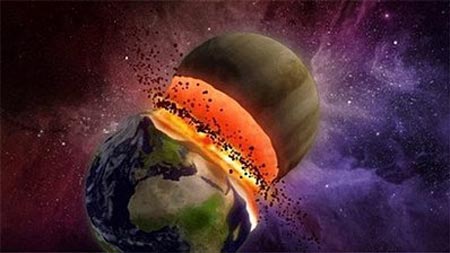The earth can hit the
As the sun turns into a red giant, the orbits of the planets near it will be disordered, leading to the risk of collisions between the planet and Mars and Venus.

Artwork collisions between Earth and Venus.Photo: Nature.
The study of the Paris Observatory (France) shows that the planets orbiting the sun will continue to maintain a stable trajectory for another 5 billion years. Then, when the core hydrogen is depleted, the sun will erupt with helium and the temperature in the core rises to hundreds of millions of degrees Celsius. It swells up into a red giant star and its outer layer reaches Earth, Mercury, Venus, Mars.
After the red giant phase, giant heat pulses cause the outer layers of the sun to fly into space to form nebulae. When the outer layers are gone, the sun turns into a cool white dwarf.
Astronomers have long been able to calculate the motion of the planets for hundreds of thousands of years with great precision. However, predicting the future of a group of celestial bodies is still beyond the capabilities of the scientific world.
'The most accurate predictions about the motion of planets in the solar system are only true for a few tens of millions of years, while the sun is still functioning normally for 5 billion years,' said Jacques Laskar, a scientist. of the Paris Observatory, said.
Thanks to the powerful computers, Laskar and his colleague Mickael Gastineau created models of the orbits of the solar system planets for the next 5 billion years. In these models, the two consider Albert Einstein's theory of relativity (which has never happened in previous simulations). In the short period of time the orbits of the planets changed very little, but after billions of years their trajectories varied greatly.
Models show 2,501 scenarios, of which 25 end with the collapse of the solar system. 'There is a scenario that shows Mars is so close to the earth. The exact minimum distance between them is 794 km. At the planetary level, that distance is synonymous with a collision. Then life on Earth will almost disappear, ' Laskar predicted.
For a more detailed view of collisions between celestial bodies, Laskar and Gastineau create 200 more models. In each Mars orbital model is changed slightly to create 200 scenarios. They found that 195 scripts ended with two celestial bodies in Mercury, the sun, Venus, the Earth and Mars colliding. 50 scenarios show that the earth shattered into pieces.
'Mercury will spark chaos. Because of the smallest mass in the solar system, it will be the first planet to drift off the familiar orbit , 'explained Laskar.
At some point Mercury's orbit will resonate with Jupiter's orbit. That event made the movement of the smallest planet in the solar system become more and more unstable. Once that happens, the so-called 'angular momentum' from Jupiter will disrupt the orbits of the planets that lie between it and the sun (including Mercury, Earth, Venus and Mars). Then our planet may collide with Venus or Mars.
'Models show that, despite being the smallest planet, Mercury is the biggest threat to the order of the solar system,' said astronomer Gregory Laughlin of the University of California.
- 10 interesting facts about Earth you may not know
- The Earth may have swallowed its planet
- The 8 biggest mysteries about Earth
- History and meaning of Earth Day
- Scientists think that these are the eight most likely cases of life eradication
- Video: Discover everything about Earth
- Unbelievable facts about the Earth
- Earth Overshoot Day - the time when humanity abused resources exceeded Earth's recovery threshold
- Revealing the mysteries of the Earth makes everyone 'startled'
- Video: Earth image at night
- Impressive image of Earth Day
- Video: Interesting things about the Earth
 Van Allen's belt and evidence that the Apollo 11 mission to the Moon was myth
Van Allen's belt and evidence that the Apollo 11 mission to the Moon was myth The levels of civilization in the universe (Kardashev scale)
The levels of civilization in the universe (Kardashev scale) Today Mars, the sun and the Earth are aligned
Today Mars, the sun and the Earth are aligned The Amazon owner announced a secret plan to build a space base for thousands of people
The Amazon owner announced a secret plan to build a space base for thousands of people